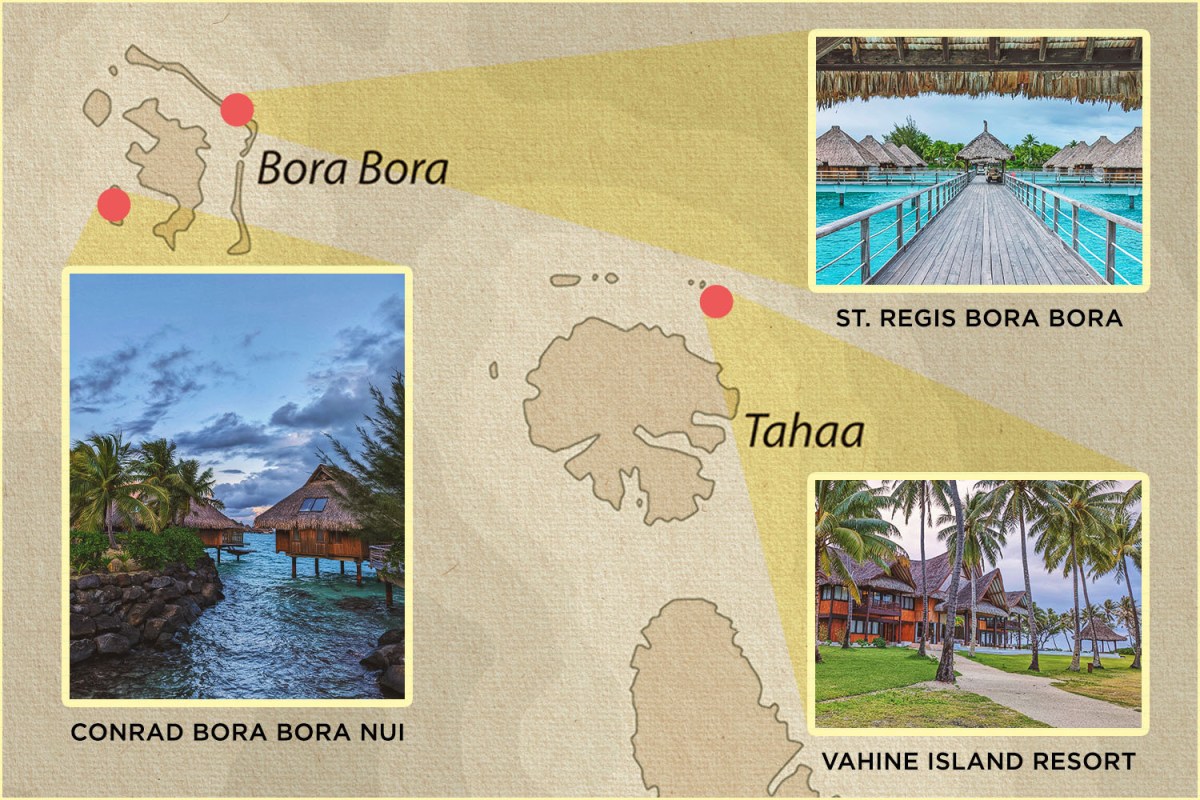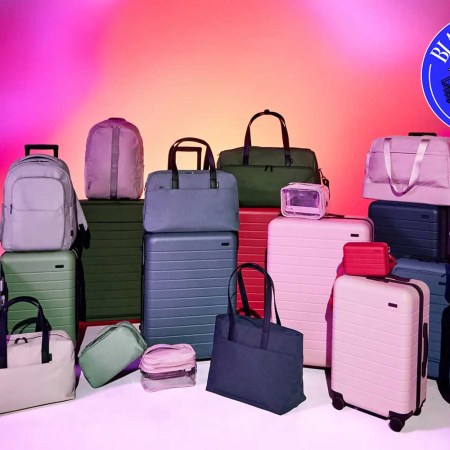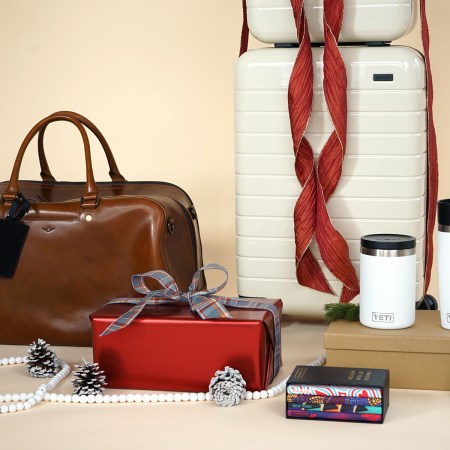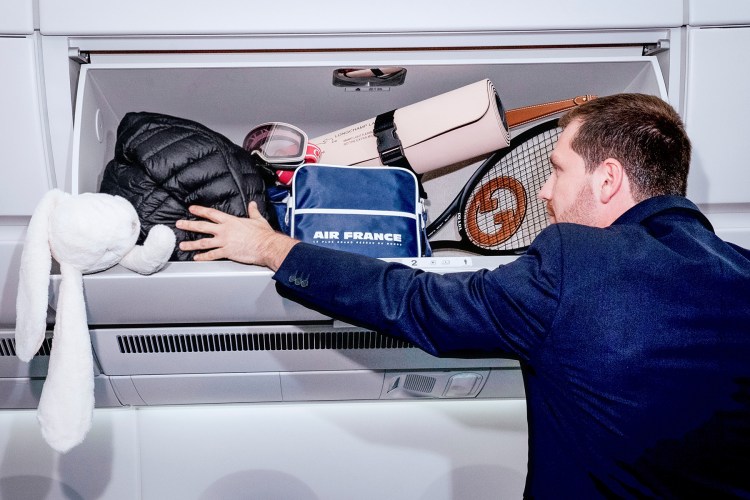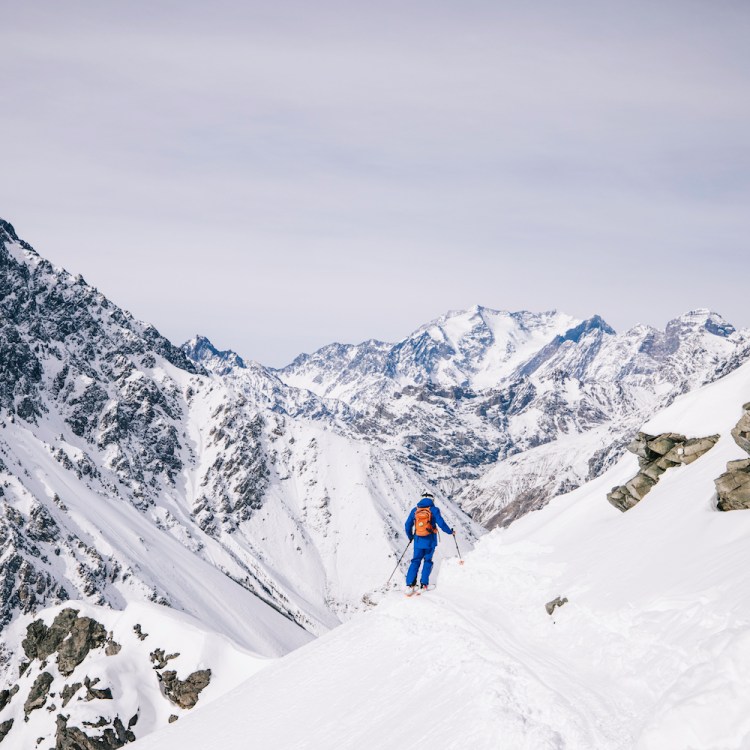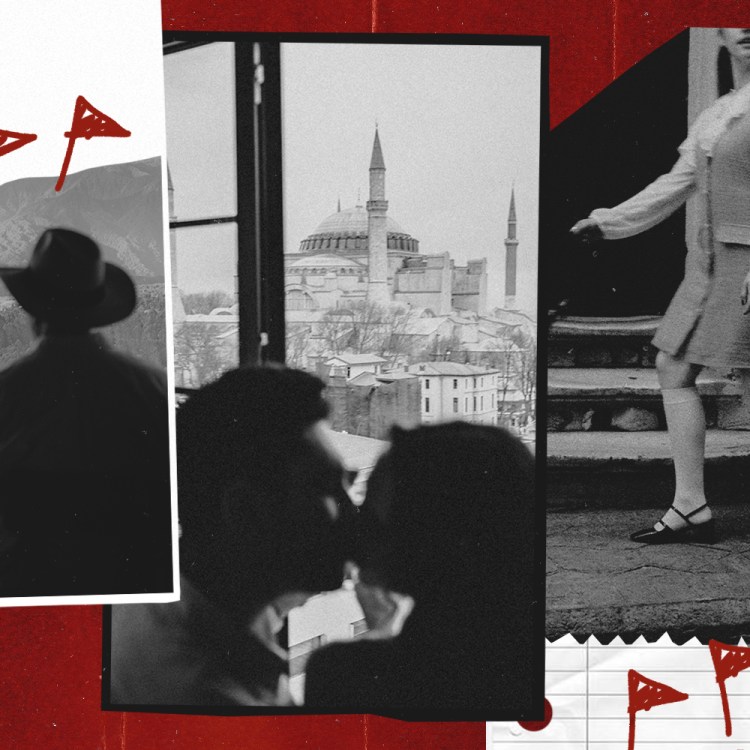The sweet smell of slow-roasting pork lures me out of my overwater bungalow at the Conrad Bora Bora Nui, and as if by instinct alone, I begin making my way down the boardwalk towards the center of the resort. I feel like a cartoon character floating above the ground in a trance with his tongue hanging out, drool falling to the floor, with a thought bubble overhead depicting the animated me licking his chops as a full pig is brought over on a silver platter.
In real life, an ahima’a — a traditional underground oven lined with stones and coconut leaves that’s used for slow cooking foods overnight or throughout the day — is being unearthed, filling the air with those rich aromas ahead of a lavish Polynesian feast and performance, and I’m quite literally salivating at the prospect of the meal.
Enormous tunas have been flayed open and rejiggered with hundreds of perfect, pink slices of sashimi on display. There’s a dozen other specialties being served up from a bountiful buffet that seemingly stretches the length of the coastline, showcasing traditional Polynesian dishes as well as the full range of culinary influences found across the islands of Tahiti, where Chinese flavors and techniques blend with French fare and are juxtaposed with Japanese ingredients. (A typical breakfast spread includes omelets and crepes, but also lo mein, miso soup and sashimi.) And that suckling pig, roasted underground for five hours, is as tender as can be, its fat and skin reduced to pure gelatinous flavor, its bones pushed cleanly aside from its meat with the gentlest of touches as you prepare for a bite.
As dinner continues unfolding, the performance gets underway, a captivating experience even beyond the hypnotizing hip gyrations of the female dancers. The men are fierce and powerful, and the dances and chants and fire throwing are all spectacular, as a group of musicians sets the scene with melodic ukulele interludes between booming drum lines. It’s a pitch-perfect soundtrack as the gentle lagoon waters crash on the reef in the distance, and a breeze blows through the palm trees with a near full-moon lighting up a clear, star-filled night sky.
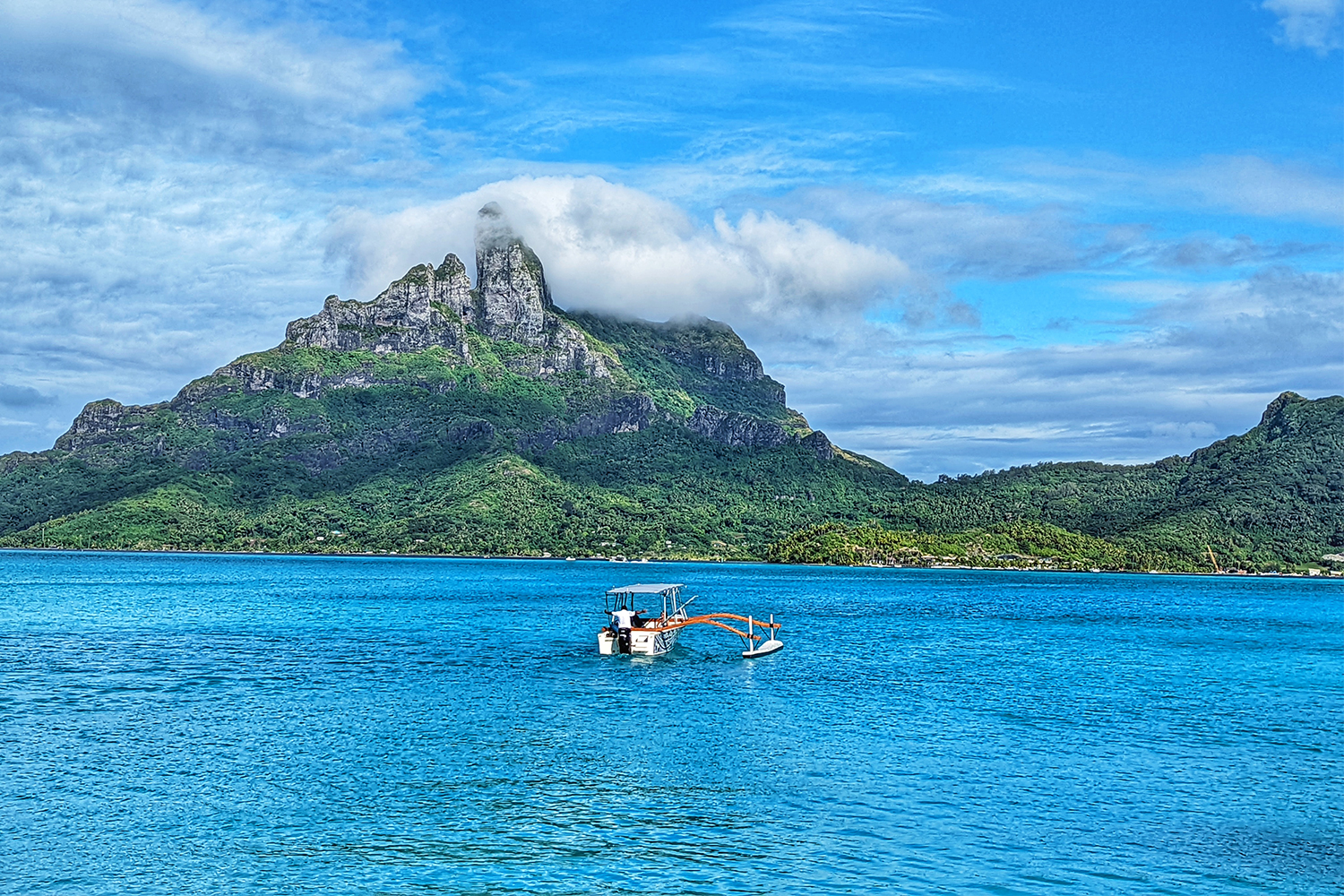
There’s More to Tahiti Than Overwater Bungalows
This may be exactly the vision you’ve been conjuring up as a reason to make the trip to the Tahitian islands. It doesn’t hurt that Tahiti is only an eight-hour flight from the West Coast — and if an eight-hour flight doesn’t warrant an “only” in your head, keep in mind it’s shorter than heading to Europe from the same starting point, for instance, and that one of the destination’s main competitors in the minds of American travelers is the Maldives, whose admittedly surreal beauty will take you at least three times as long to reach.
Air Tahiti Nui offers daily flights from Los Angeles and is adding nonstop service from Seattle in October. Plus, they’ll help you absorb that Tahitian vibe along the way, with fragrant flowers doled out to transport you mentally even as you’re physically making the trip. You can even study up on the islands and their culture with an interactive portal within your seat’s entertainment display, ensuring you at least know how to say hello (ia orana), thank you (māuruuru) and cheers (manuia), by the time you step off the plane.
The islands of Tahiti are likely more diverse than you imagine. Tahiti itself is the main and most populous, home to about two-thirds of the total population of roughly 300,000 residents, as well as the capital city of Papeete. But French Polynesia on the whole consists of 121 islands and atolls, 75 of which are inhabited. You won’t make it to most of them on a single trip, but you should definitely include a handful, and you’ll find that each island has a unique personality entirely its own.
While those overwater bungalows on Bora Bora may be what you or I dream about, it’s far from the norm. Consider the island of Raiatea, where there’s now an abundance of Airbnbs and family stays, but not a single resort.
“It’s because of the deep wish of the people here,” my guide Tara tells me. She can trace her lineage back 1,200 years on the island, and at her last family reunion she counted 289 relatives, stopping at first cousins. “Living on Raiatea means you are on a piece of heaven on earth,” she says. “But there is no privacy, everybody knows everybody!” Sounds like she’s speaking from experience. She leaves me with some parting wisdom, too. “Never challenge a Polynesian woman to a drinking contest.” Noted.
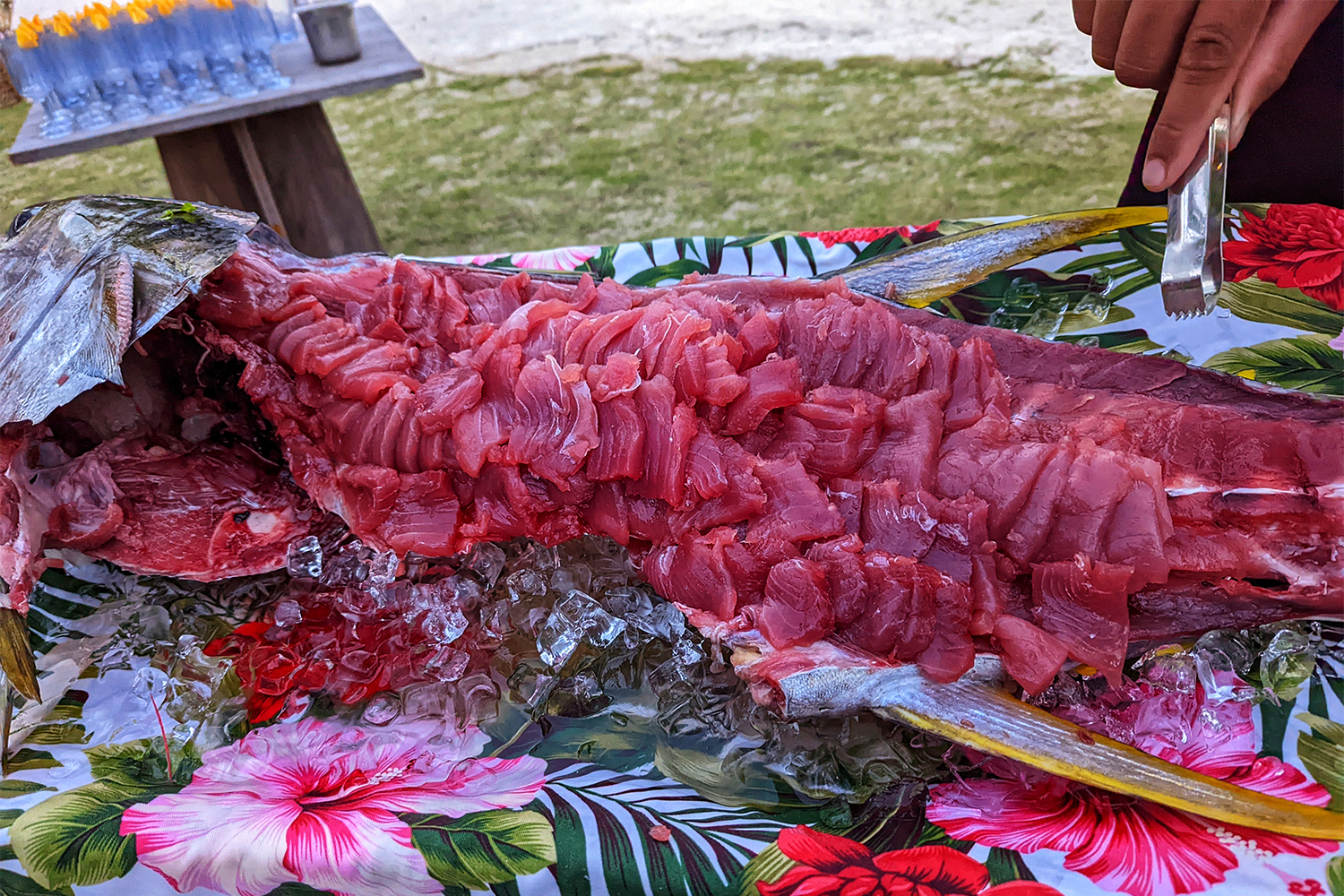
Learning the ins and outs of the culture and how every island offers its own take on tourism is essential during a trip to Polynesia. As culture and food are inherently intertwined, I was also focused on eating and drinking my way across the region. One of the places I was able to explore that in full was at the Food & CookLab Tahiti on the island of Moorea. Founded by Audrey Lachaud, and operated by her and her partner Stevenson Vahimarae, a Bora Bora native, it’s a project dedicated to local food and producers.
Guests can take immersive cooking classes, which help to fund the overarching mission, including a shared space for purveyors to produce their wares, along with a garden growing an abundance of fruits and vegetables — breadfruit, limes, pumpkins, coconuts, pineapples, starfruit, taro and much, much more. Cooking class attendees come away with a wealth of knowledge to go with a very full belly after scarfing down the half dozen dishes they help to prepare.
“We’re trying to promote local food and also people having opportunities to come and do their own projects here,” Lachaud says. “This is the only place like this here that I know.”
A Souvenir Steeped in Polynesian Tradition
Beyond the food, though, one of my key cultural explorations was something off the beaten track for most travelers: coming home with a traditional tattoo souvenir. What better way is there to experience and connect with a culture than by partaking in one of its fundamental, foundational practices? And make no mistake about it, that’s what tattooing is across Polynesia — the word tātau, which can be translated as “to make marks by striking,” is where we get the word tattoo, after all — despite lengthy periods of colonial powers criminalizing and stigmatizing the art and its meaning.
“Tattoos are our identity; we don’t have a book to write in,” Vahimarae of the Food & CookLab explains to me. Family history, social status, where you’re from and who your people are, your life story and your family’s stories, this is all captured in a tattoo’s symbols, the skin of your body morphing into the pages of a memoir detailing everything about your place in the world.
In the past, receiving such a tattoo wouldn’t have been possible or approved of for an outsider, but today it’s viewed as a means of cultural exchange. “Now it’s an honor for us that you can go and show our culture to the world,” Vahimarae says. “We are a small people,” he adds, referring to the population size. But cultural influence, from tourism and food, from outrigger canoes and tattoos, amplifies and spreads their presence around the world.
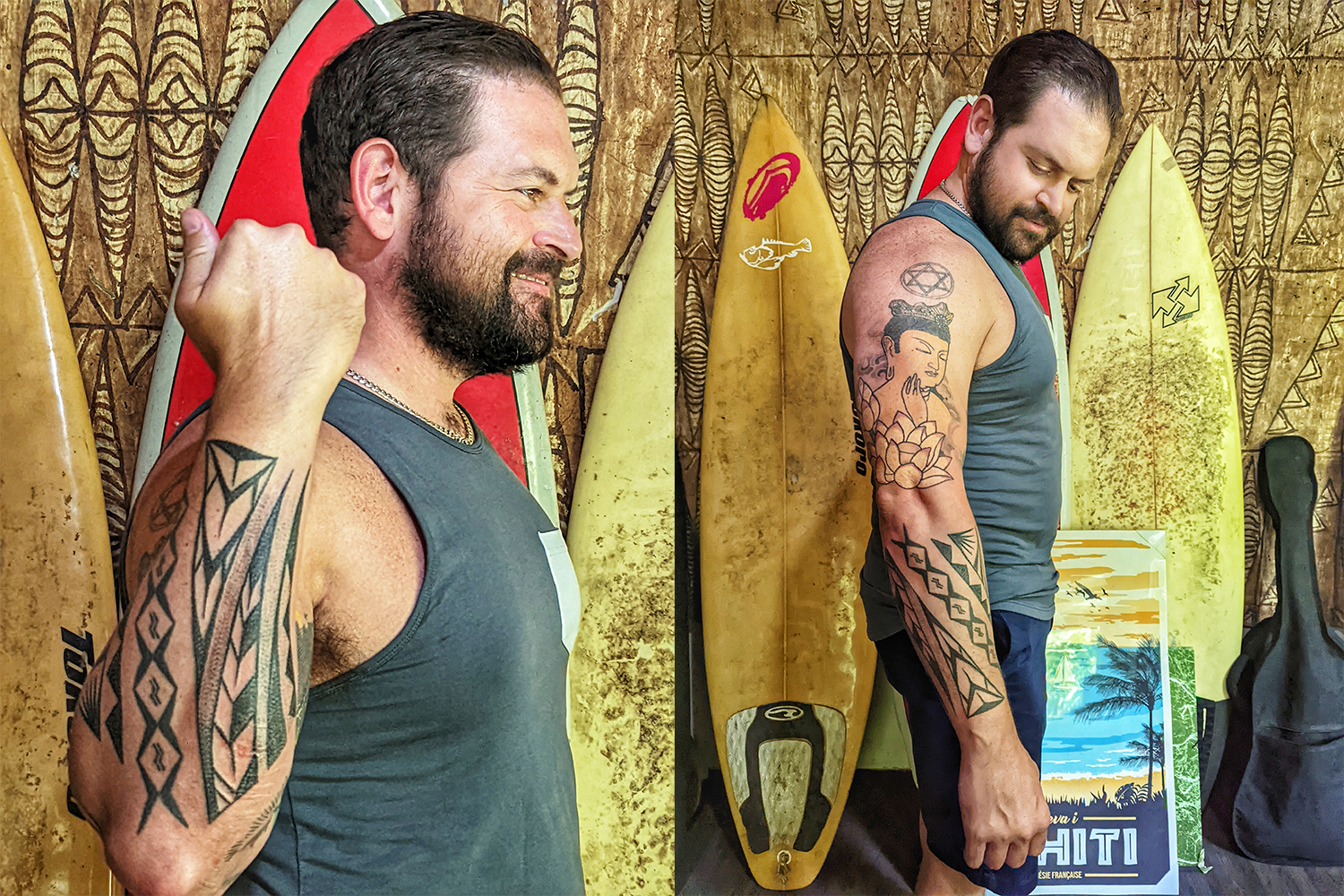
Receiving tattoos performed with traditional methodologies is something I’ve done across the world, and whether it’s a fervent passion or an unhealthy obsession might depend on which of my family members or friends you ask. My first venture was receiving a Japanese tebori, or hand-carving tattoo, by a master of the craft in Tokyo. In Cambodia, I was spurred on by locals to receive a sak yon tattoo performed via bamboo needle. And in New Zealand, I received a Māori tā moko performed by wooden tapping tools.
That last tattoo wraps around the length of my right forearm, and was recognized in an instant by Tahitian tattooist James Samuela, who’s been practicing and reviving this traditional art for the past 20 years. Māori and Polynesian cultures are closely related, as are their tattoos, both in the method of tapping as well as their artistic symbolism and appearance. Therefore, when James asked me about the tattoo, what it meant and where I got it, it was more to suss out whether I knew, and perhaps whether I was approaching the endeavor from the right place, as opposed to his own edification.
He built around the existing design of shark teeth and ocean waves, representing strength and protection, spirituality and life’s journey, connectedness to the whole of the world, with the same concept and iconography. The result was a shining sun in the sky, and a strong wind filling up a boat’s sails. For a people whose livelihood might depend on the success of a sailing voyage in a handmade craft, traversing the seas required knowledge, strength and determination. The tattoo was performed via tapping, with the implements crafted by James himself. He carved and fashioned a razor-sharp, multi-pronged ivory comb from a pig’s tusk the morning before our session, and gifted it to me afterwards.
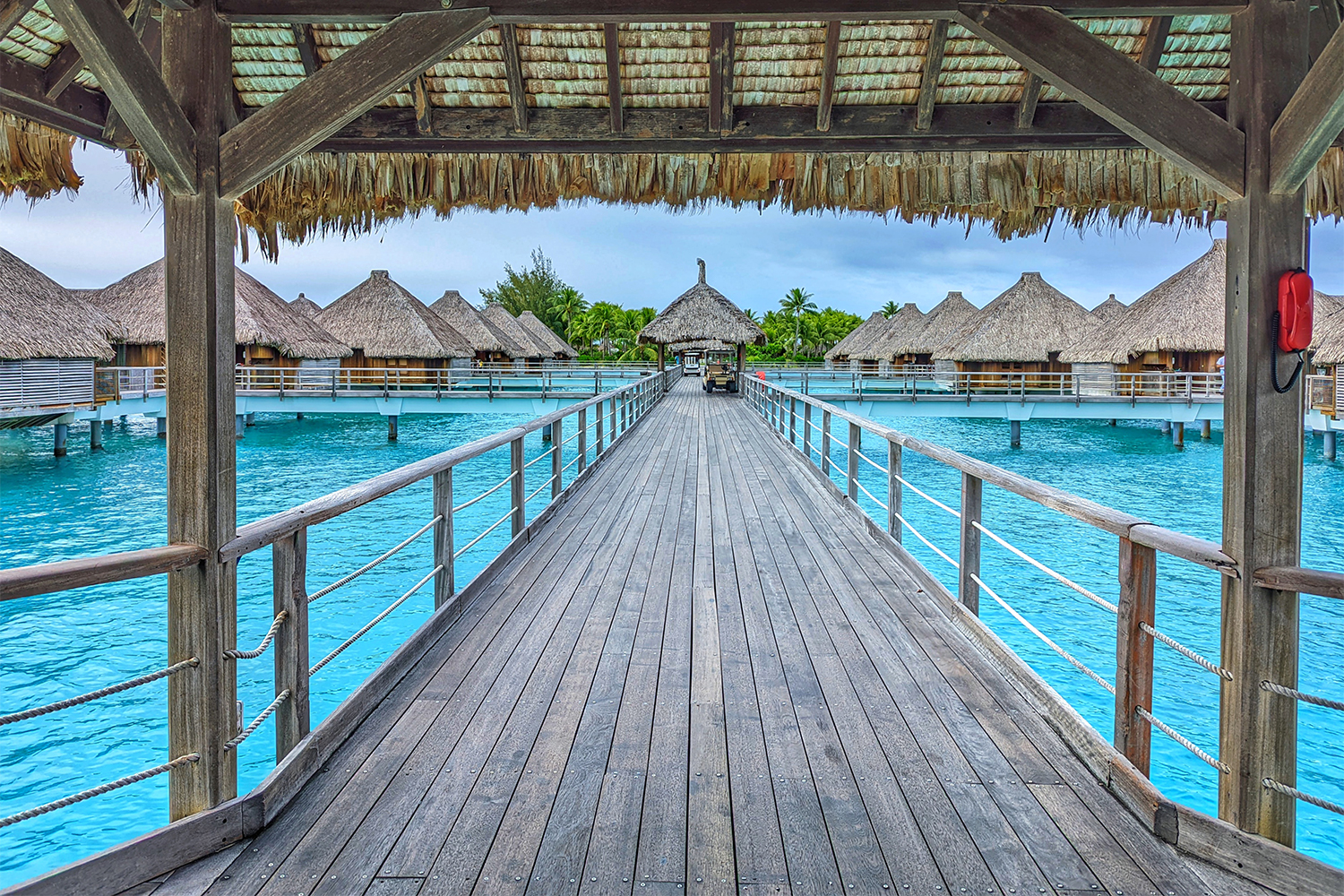
Where the Luxury Resorts Await…
You’ll have your own reasons for heading to the Tahitian islands, though, and it’s probably more along the lines of squeezing in as much world-class snorkeling or scuba diving as possible. Or maybe it’s maximizing relaxation time at beautiful beaches with vibrant waters in a spectrum of shades.
Pursuing some top-flight indulgence was on my agenda as well, and The St. Regis Bora Bora Resort was beckoning. I needed some R&R after the tattoo, right? The St. Regis epitomizes the island’s natural beauty and its penchant for serious swank. Surrounded by the insane colors of the lagoon and with views of the famed Mount Otemanu peak, the resort’s massive overwater bungalows sport features like glass floor cutouts for ocean viewing and direct water access from private decks. Bathrooms feature two-person soaking tubs adjacent to sexy stone-tiled showers absent of any cordoning off from the rest of the space, ideal for whether getting clean or getting dirty, as it were.
There’s always a higher level on Bora Bora, though, and private islands abound. When I was at the St. Regis, Snoop Dogg and his son and crew were staying at the private Bora Bora One, busy Instagramming the experience to their followers. Keep in mind that a beginning budget for a vacation at that particular property probably starts with a one and ends with five zeros. Elsewhere around the islands, the newly opened Motu Nao Nao is another super-luxe offering, with three villas available for exclusive rental on a private 26-hectare island.
Such properties are found on islands known across Tahiti as motus, which are tiny islets found ringing around the lagoons and reefs of larger islands and atolls. Many of these are still owned outright by locals, who may have divvied them up into small slivers for each child from one generation to the next, and are used as idyllic, personal weekend retreats.
“The difference between the main island and the motu is that the main island is the town and the motu is the country,” a local guide tells me. Nothing but sand and palm and coconut trees, surrounded by some of the world’s most pristine swaths of ocean. Not too shabby for a “country” escape that’s a quick 10-minute boat ride across the lagoon.
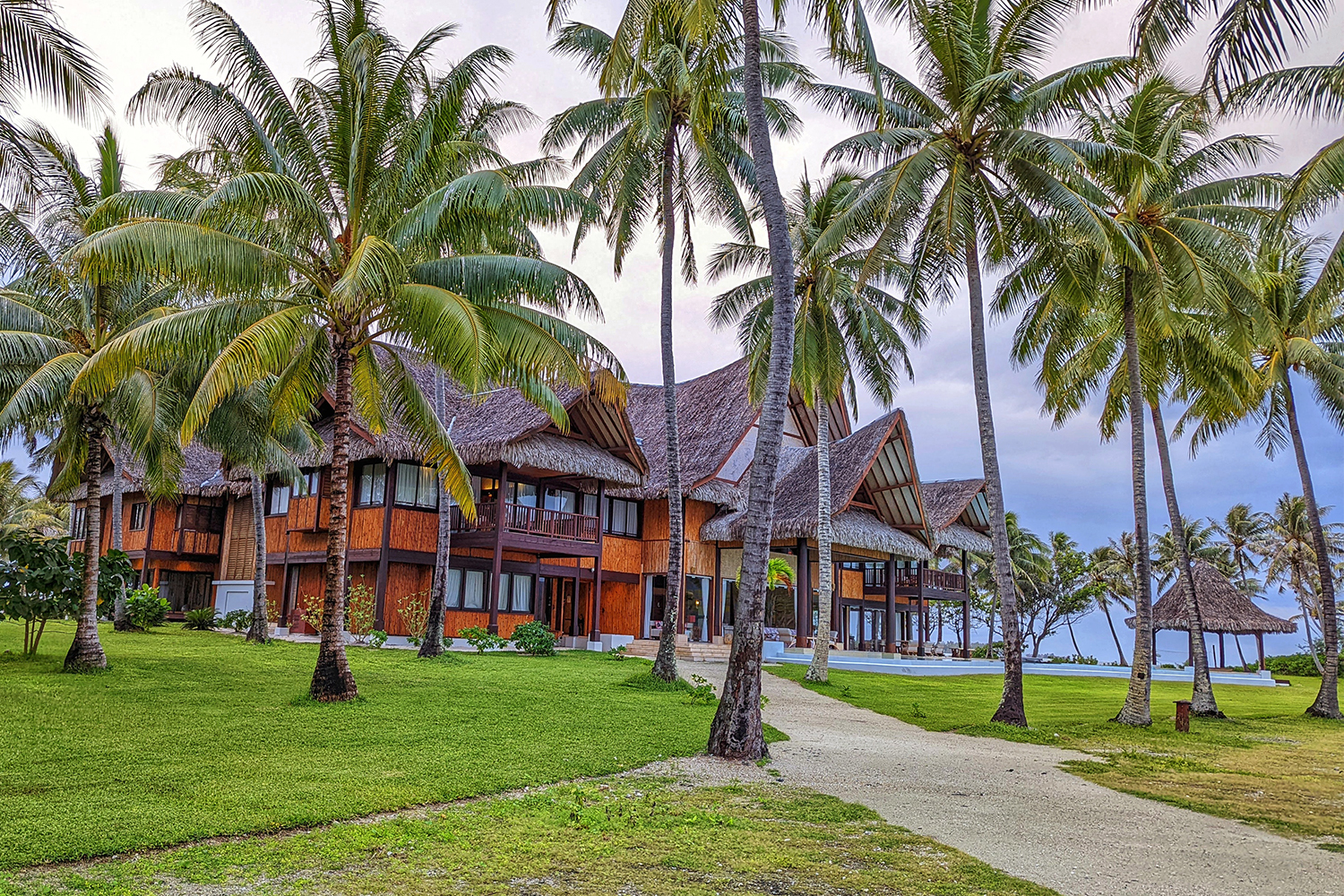
Other motus may be either inhabited or open to the public, and there are certainly more accessible options with more affordable price tags. Consider Vahine Island, a member of the Small Luxury Hotels of the World group that’s positioned across from Taha’a.
“This is what people think French Polynesia was like 20 or 30 years ago,” one of my hosts at Vahine tells me. It’s more Robinson Crusoe than a six-figure media mogul escape on Bora Bora, while still excelling at attentive service and offering a brilliant, unspoiled beach locale. The resort comprises three small motus, with nine overwater and beach bungalows combined, along with a new addition, La Villa Royale, a six-bedroom island manor with a wraparound indoor-outdoor pool as its centerpiece.
And just as there’s always another more exclusive and expensive resort, in French Polynesia, there’s always another more remote and hidden enclave. At the end of a day-long excursion filled with Taha’a’s rum distilleries and vanilla farms, my guide George drops me off on his family’s motu, a piece of which he operates as a de facto private beach club.
A single table is positioned at the corner of a tiny, perfect stretch of sand, with a little palm tree beside me, massive brain coral mere steps offshore, and a lunch spread with whole grilled fish and coconut bread and taro and Tahitian poisson cru, the national dish of tuna ceviche doused in coconut milk, all brought to the table alongside potent rum punch. There’s nothing but the gorgeous South Pacific expanse ahead of me in every direction — not a chain hotel or selfie stick, or for that matter, another tourist, in sight.
It’s the Tahitian dream writ large, or at least one version of it, and whatever that special image of Tahiti is that you’ve been dreaming about, it’s there for you to find.
This article appeared in an InsideHook newsletter. Sign up for free to get more on travel, wellness, style, drinking, and culture.
